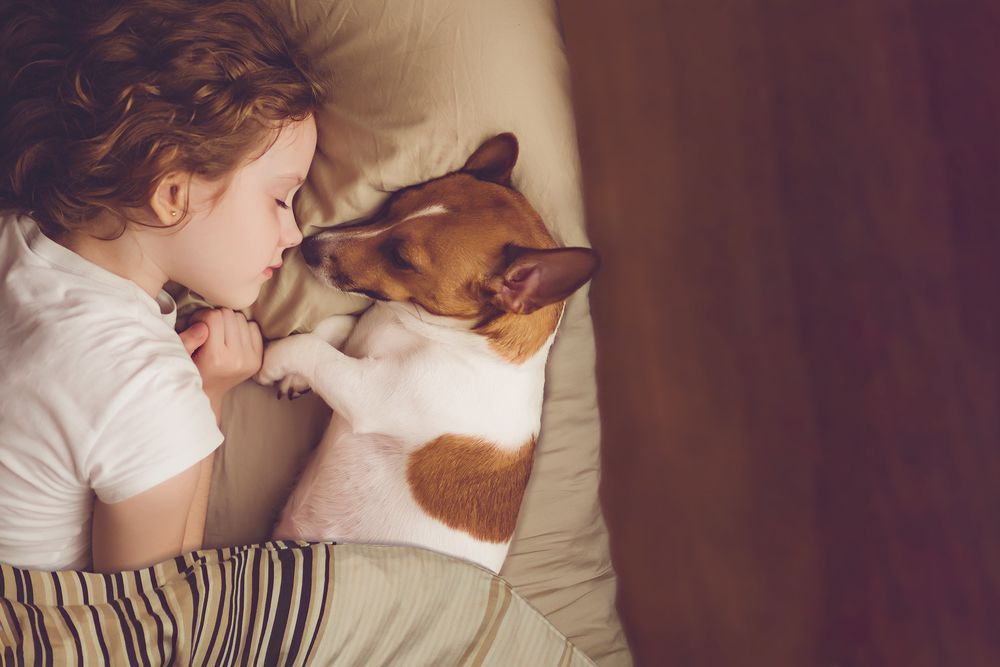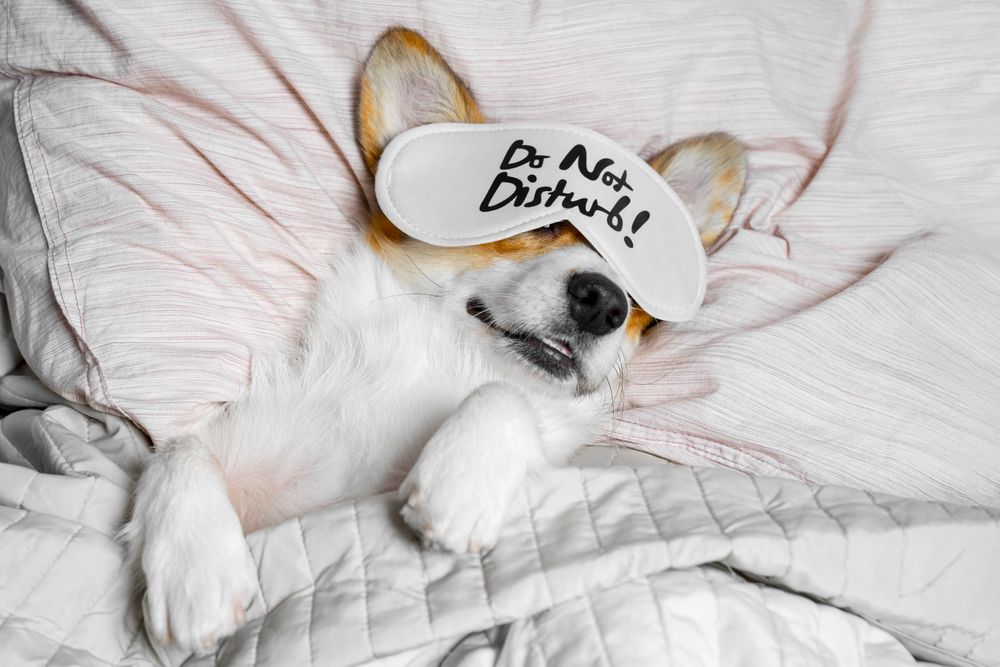It’s a Dogs Life
If you have a dog, you’ve probably wondered what happens when they shut their eyes. Do they have dreams just like humans, or are their movements while dozing an involuntary twitch? We’re going to answer the questions on your mind, so you can get a better understanding of your puppy and what they think about while catching some Zs.
Do Dogs Dream?
Scientists believe that dogs have the capability of dreaming just like us humans. Nearly all mammals, as well as birds and reptiles, go into stages of rapid eye movement (REM) sleep and slow-wave sleep. Rapid eye movement sleep, which we also know as REM sleep, is the sleep that occurs in intervals. It is characterized by eye movement, body movement, and faster breathing. This stage of sleep is the most memorable and is the time when humans and animals have their most vivid dreams. During the slow-wave phase of sleep, the dog’s breathing, heart rate, and blood pressure decrease.
Science Has Proven Animals Have REM Sleep
Scientists first discovered that animals could dream during a 2001 study into rats. The rats spent their day running around a maze while the scientists monitored their brain activity. They then compared it to the rat’s brain activity during REM sleep and found that the same areas of the brain lit up during both periods. This discovery meant that the rats dream of the maze they ran around that day. The researchers could even go one step further and figure out where in the maze the rats were dreaming themselves into. Pretty cool, right? Like humans, the rats dreamed about their day, and the study concluded that animals are capable of complex dreams and can replay events while sleeping, just like you and I.
What Do Dogs Dream About?
Science is amazing, and researchers conjured a test to determine what dogs dream about. The test required them to disable the pons in a dog’s brain temporarily. The pons are part of the brain stem responsible for controlling sleep cycles. It also helps regulate deep sleep and inhibits your large muscles from moving. Put it this way; if our pons didn’t work, we’d be acting out our dreams in our sleep. Which, if you think about it, could have extremely dangerous results. You can thank your pons that you haven’t injured your partner while sleeping or vice versa. If you’re a dog owner, you would have noticed your dog twitch in their sleep, which is even more evident in puppies or senior dogs. Puppies and older pooches have underdeveloped and less efficient pons’ which in turn means that the dreams they’re having they’re acting out in their sleep.
Dog Dreams and Sleep Cycles
To figure out what dogs dream about, the researchers decided to temporarily disable the pons during a REM sleep period and monitor how the dog’s body reacted. They found that dogs dream about their days, their encounters, and, overall, that dogs dream doggy things. If you took your pup to the park that day, they probably dream about it. If you gave them their favorite treat, they’re probably dreaming about it. If they had a play date with their best pup friend, you guessed it; they’re probably dreaming about it.
Do Dogs Dream About Their Owners?
Following on from what dogs dream about, their dreams could include you. You, as an owner, are your dog’s entire world, and a vast majority of your dog’s day is spent with you by their side. Studies have shown that dogs dream about the events of their days; therefore, it’s safe to say that their owners would feature in some dog dreams. However, although we know that dogs can dream and that the events of their day play out in their heads, it’s hard to tell what role we humans would play in their dreams. Do they dream of cuddling up next to us? Or us throwing a stick for them to play fetch with? In some ways, it’s better left up to the imagination. Dog owners worldwide will smile happily, knowing their dog’s sweet dreams could be all about them.
Do Dogs Have Nightmares?
Dog brains, just like humans, hold onto the bad things that happen in their lives. Not all our dreams are sunshine, rainbows, and unicorns, and that’s the same with dogs. Watching your dog go through a nightmare can be difficult, but waking them up is risky and unadvised. When we wake from a scary dream, it can take a few seconds to minutes to adjust to where we are and who we are with. People can sometimes act hostile in that uncertain time, and the same goes for dogs.
Always Let Sleeping Dogs Lie
If we were to wake a dog from a bad dream, they could act aggressively, even if they’re normally a mellow and well-behaved pup. This aggression can result in dog bites, so it’s best to leave your dog to ride out their dream and comfort them when they eventually wake up. As that old saying goes, “let sleeping dogs lie.” Signs of a bad dream in a sleeping dog are whining, twitching, or general sounds of distress. Instead of touching your dog, you can try calmly talking to them to break them out of their dream, or if you know, they won’t be startled by you touching them, gently pat them or move an item close to them. If your dog is showing signs of fear or aggression, however, it’s best to leave them alone; they’ll come out of it, eventually. In addition, monitoring your dog’s sleep is recommended as increased nightmares or nightmares that occur out of the blue could be a sign of an undiagnosed medical issue.
Do Some Dogs Dream More Than Others?
The amount people dream varies from person to person. Some people have vivid dreams regularly, whereas some can go months without any dreams occurring. This, too, varies in dogs. Some scientists report that small dogs’ dreams occur more frequently than larger dogs. However, smaller dog breeds have shorter dreams, and large dog breeds experience longer dreams. Puppies and smaller dog’s dreams can be 60 seconds in length and occur every ten minutes or so. In contrast, larger dogs may have dreams lasting five minutes every few hours.
What Are Signs of a Dog Dreaming?
Common signs of dreaming are your dog twitching in their sleep, sleepwalking, quivering, or whining. Their actions while sleeping could give us an indication as to what they’re dreaming about. For example, if they’re sleepwalking or running, they may be dreaming about playing fetch. And if they’re barking while sleeping, they could be chasing a squirrel or cat up a tree. Monitoring our dog’s sleeping habits can give us a better understanding of our canine companions. For example, if they’re experiencing nightmares, there may be something traumatic happening in their lives. And if they seem to be happily playing throughout their sleep cycle, we must be doing something right.
Do Dogs Get Sleep Paralysis?
Sleep paralysis is the inability to move while feeling conscious. It usually occurs when humans pass through the multiple sleep stages of being awake and asleep. What causes sleep paralysis is a lack of sleep. This could be from a changed sleep schedule, new medication, or sleep-related issues. Luckily for our furry friends, sleep deprivation is extremely rare because they can fall asleep whenever they want.
Final Thoughts on What Do Dogs Dream About
Dogs sleep for 12 to 14 hours every day, and although we can’t exactly pinpoint what they’re dreaming about at any given moment, we can get a brief idea from their actions, noises, and movements while sleeping. Just like human dreams, dogs’ dreams can be complex, vivid, and lifelike. If you have a pooch at home, spend some time watching them sleep. Do they show any signs of dreaming. As we come to a close, it would be interesting to know if you have any funny stories of your dog dreaming. Have they fallen out of bed because of it? Or made any funny noises? Let us know in the comment section below!









